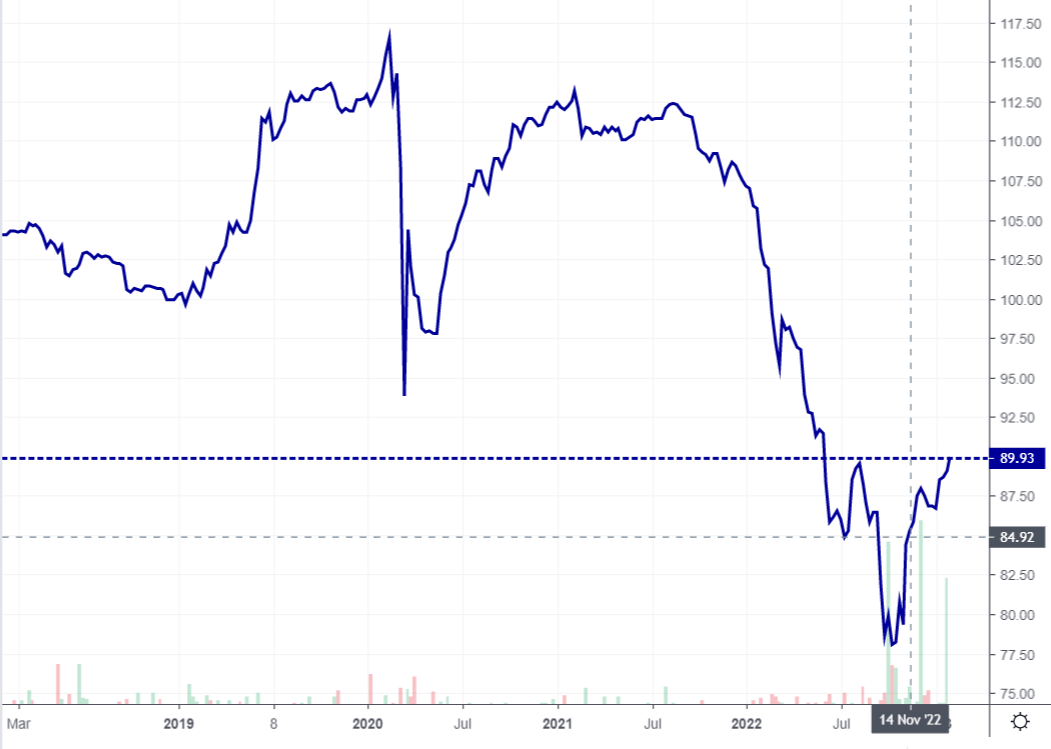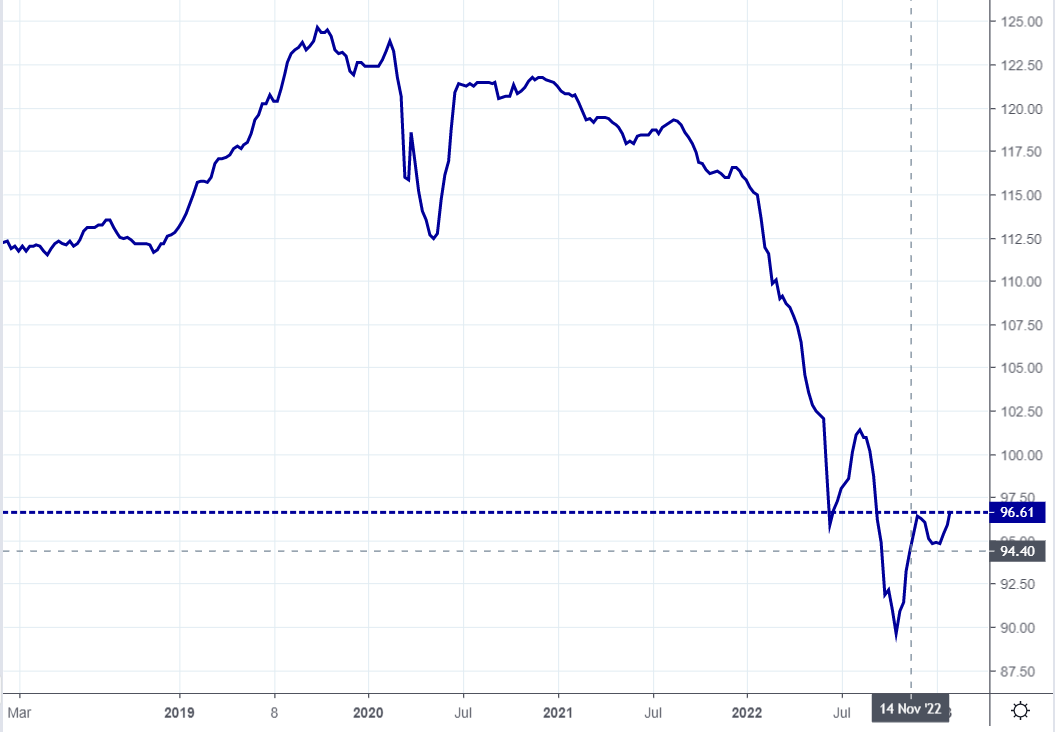Eastern European Bonds as a Good Bargain (Revisited)


On Nov 16 last year, we published our blog post ‘Are Eastern European Bonds Way Too Undervalued,’ where we made the case that Bulgarian and Romanian government bonds were a bargain at that time. It has been three months since our overview — let’s see what has happened since.
In our analysis, we have chosen a specific duration — 5-year bonds. Let’s take a look at our Romanian bond first — Romania 2.875% 2028:

You can see that at the time of our original publication, the bonds were trading around a clean price of 84.92. Currently, they are selling at 89.93 clean prices. With the accrued component of nearly 0.70 cents, our recommendation has shown an appreciation of approximately 5.70 points for three months or almost 6.7% — given our initial capital outlay was 85 points. Not that bad at all!
Let’s look at Bulgaria’s 3% 2028:

At the time of our publication, the bond was trading around a clean price of 94.40 (dotted line). At present, the clean price is 96.60, and with an accrued component of 0.75, our recommendation has appreciated 2.95 points (2.2 +0.75) on 94.40 invested capital or around 3.1% for a three–month period.
Those are good returns, and as you can see from our first publication on the topic, we correctly ranked those trades — Romanian bonds (best idea) and Bulgarian bonds (alternative choice). The question is — now, do we sell, hold or buy even more?
2022 turned out to be one of the worst years for fixed-income securities in almost any currency. What is interesting about the EUR-denominated fixed-income securities is that instruments issued by Eurozone/Euro area governments moved in ‘parallel’ to those issued by Germany.
Let’s use Greece as an example:
| Date | Germany 5 Yr | Greece 5 Yr | 5 Yr Spread of Greece ооver Germany |
| Dec 2021 | -0.45% | 0.61% | 1.06% |
| Jan 2022 | -0.27% | 0.82% | 1.09% |
| Feb 2022 | -0.13% | 1.42% | 1.55% |
| Mar 2022 | 0.37% | 1.63% | 1.26% |
| Apr 2022 | 0.68% | 2.33% | 1.65% |
| May 2022 | 0.84% | 2.51% | 1.67% |
| Jun 2022 | 1.10% | 2.72% | 1.62% |
| Jul 2022 | 0.53% | 2.43% | 1.91% |
| Aug 2022 | 1.38% | 3.34% | 1.96% |
| Sep 2022 | 1.96% | 4.09% | 2.13% |
| Oct 2022 | 2.01% | 3.94% | 1.92% |
| Nov 2022 | 1.95% | 3.28% | 1.33% |
| Dec 2022 | 2.57% | 3.71% | 1.14% |
| Jan 2022 | 2.30% | 3.39% | 1.09% |
It can be seen from the chart above that while 5-year bonds’ government bond yields in both Germany and Greece rose quite dramatically in 2022, the difference between the two in January of 2022 and January of 2023 is actually the same — 1.09%!
We are looking at Greece as an example, but the same conclusion can be drawn for ANY eurozone/euro area government bonds! It seems that in times of drastic bond market moves, investors prefer buying bonds that ECB can support.
Bulgaria and Romania, however, are NOT members of the eеurozone/euro area. And we can see the difference in their respective performance.
Let’s take a look at Romanian 5-Year EUR and Bulgarian 5-Year EUR – denominated government bond yields versus those of Germany:
| Date | Germany 5 Yr | Bulgaria 5 Yr | Romania 5 Yr | 5 Yr Spread of Bulgaria over Germany | 5 Yr Spread of Romania over Germany |
| Dec 2021 | -0.45% | 0.38% | 1.63% | 0.83% | 2.08% |
| Jan 2022 | -0.27% | 0.52% | 1.99% | 0.79% | 2.26% |
| Feb 2022 | -0.13% | 0.97% | 3.20% | 1.10% | 3.33% |
| Mar 2022 | 0.37% | 1.28% | 3.23% | 0.91% | 2.86% |
| April 2022 | 0.68% | 2.17% | 4.00% | 1.50% | 3.33% |
| May 2022 | 0.84% | 2.55% | 4.46% | 1.71% | 3.62% |
| Jun 2022 | 1.10% | 3.57% | 5.87% | 2.47% | 4.77% |
| Jul 2022 | 0.53% | 2.97% | 5.18% | 2.45% | 4.66% |
| Aug 2022 | 1.38% | 2.92% | 5.78% | 1.54% | 4.40% |
| Sep 2022 | 1.96% | 4.71% | 7.65% | 2.75% | 5.69% |
| Oct 2022 | 2.01% | 4.88% | 7.13% | 2.87% | 5.12% |
| Nov 2022 | 1.95% | 3.81% | 5.82% | 1.86% | 3.87% |
| Dec 2022 | 2.57% | 4.12% | 5.76% | 1.56% | 3.20% |
| Jan 2022 | 2.30% | 3.96% | 5.46% | 1.66% | 3.16% |
As you can see, the spread has still NOT returned to its ‘normal’ level of 2%. It is still at a relatively elevated level of 3% but it has improved a lot since we first mentioned it when levels were close to 5%!
Do we still like the long position in Romanian government bonds? Yes, we do!
- Are we willing to buy more? Yes, we would, but only at levels below a 3.5% spread versus German bonds (below current levels).
- When are we ready to sell/close? When the spread between Romanian and German 5-year EUR yields approaches 2.00%-2.25%.
- What does this mean in terms of an upside? With a modified duration of roughly around four and a spread dropping 1%, it means we are looking for four more points in profit on the position.
Similar to Romania, Bulgarian 5-year EUR-denominated bonds trade cheaper relative to their German benchmark. We see that the levels of 1.66% are better than the levels of 2.87% when we first mentioned the trade, but we still think there is room for the bonds to improve, and we would NOT be a seller at present.
- Are we willing to buy more? Yes, but only at levels of the spread below 2%.
- When would we sell? When the spread falls below 1%,ideally to a level of 0.80%.
- What does that mean in terms of an upside? With a modified duration of around four and a 0.80% contraction in the spread, it means we are looking for three more points of profit on the position.
Sources:
Bulgarian National Bank https://www.bnb.bg/
Investing.com https://www.investing.com/
Disclaimer:
